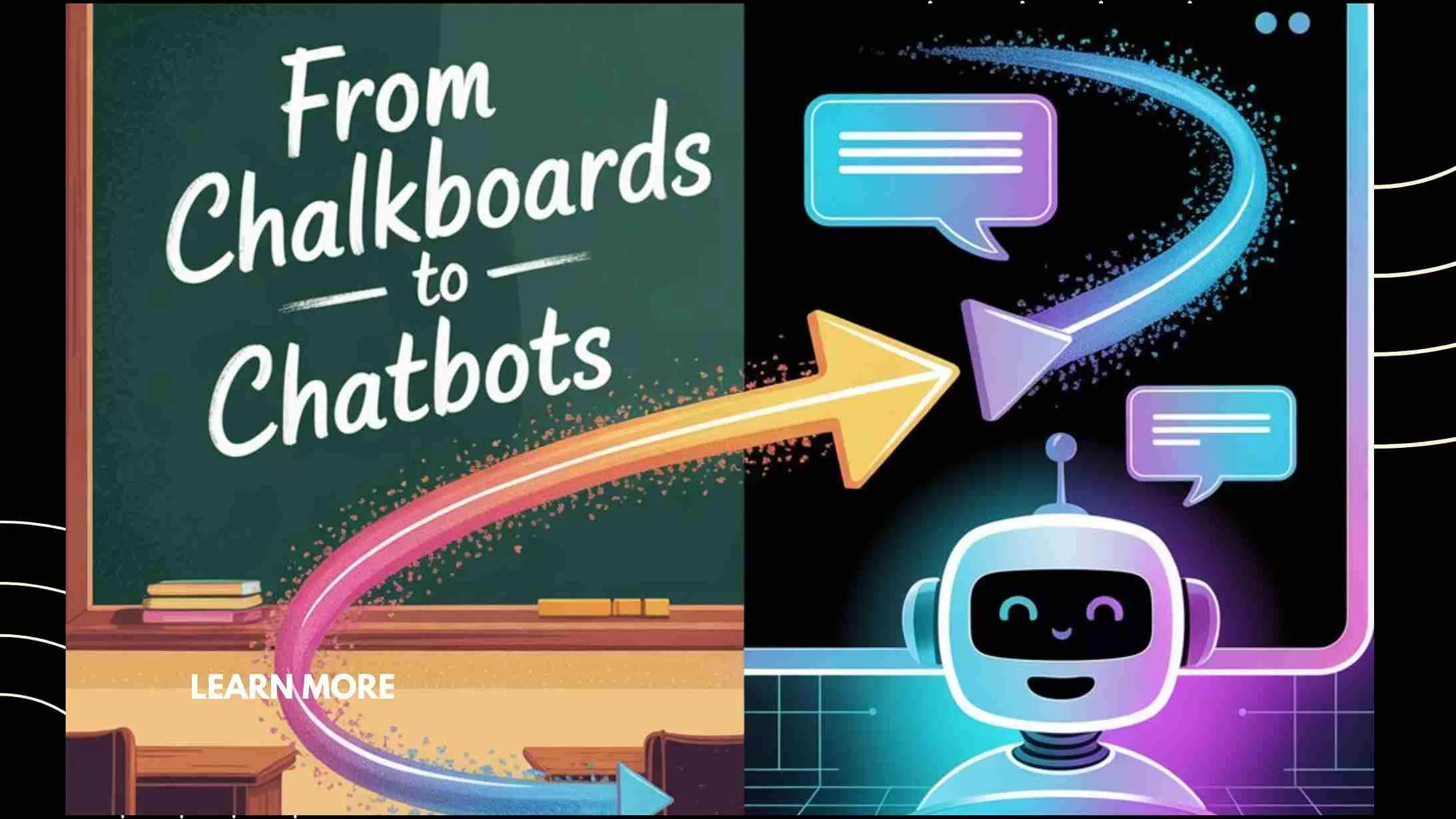I want you to imagine a class where you could step in and feel that every lesson was made and delivered to your learning capacity, a class that would get answers instantly. And curricular challenges were made and adapted to your skill levels. This is not something straight out of sci-fi; it’s reality in a contemporary education system with the incorporation of AI.
Over the last few decades, classrooms have undergone a dramatic shift where chalkboards were replaced with interactive whiteboards, printed textbooks have been replaced with digital resources, and artificial intelligence is now transforming more than just the way students learn and teachers teach. AI in education is not only transforming traditional approaches; it is about extending those approaches.
You might wish for everything to be planned and resourced for you to have a personalised learning experience, and you might want to move towards predictive analytics tools that enable educators to identify students who require additional academic support, all to make learning more engaging and inclusive both in-class and out.
In this blog, we will look at AI’s evolution from being a technological distraction to becoming an essential component of education in the UK, facilitating the creation of future classrooms, all whilst the visions of the potential with AI will be a lot more accessible through the growth of apps and tools for students and educators alike.
Evolution of Teaching Methods
Education has always changed with the times, from slate and chalk to printed textbooks, radios, and projectors. Each development in technology has affected how teachers present their lessons and how students acquire knowledge in modern times. AI is the latest evolution. As of 2025, the percentage of students using generative AI tools like ChatGPT for assessments has increased from 53% last year to 88% this year. Differentiated from typical tools, AI applies not only to load content appropriate to a student’s scope of knowledge, but also responds with adjustments to the student’s needs. By analyzing patterns of learning behavior, AI can understand strengths, weaknesses, and preferences of a student’s learning style to enable personalizing of lesson delivery previously thought impossible.
Understanding AI in Modern Classrooms
The term AI in education is broader than just robots or other forms of virtual assistants. It can also include machine learning algorithms, adaptive learning systems, predictive analysis, and natural language processing. AI technologies are also working behind the scenes to personalize study plans, recommend supplementary resources to students, or even automate some administrative tasks.
For the majority of the students, this could mean lessons that would match their pace, and for teachers, it translates into data variabilities that are measurable while reducing the workloads for repetitiveness. AI is essentially a digital partner to educators to optimize the learning environment for more effective student learning.
Why AI Matters for Students and Teachers
Adoption of AI in education addresses two very crucial goals: enhancing student engagement and improving learning results. By delivering targeted content, providing regular feedback, and continuously adapting to challenges, AI helps students to remain motivated and invested in their studies. For teachers, it offers tools to monitor the ongoing performance trends, identify at-risk learners at the earliest, and even make informed instructional decisions. As a result, a classroom where learning isn’t only efficient but also more responsive to the needs of every individual.
The Practical Power of AI in Education
Artificial intelligence has quietly become the backbone of many classroom technologies, even for the students or teachers who don’t explicitly notice it. From grading assistance to lesson personalization, AI is shaping modern learning experiences in ways that make education even more accessible, fluent, and inclusive.
Personalised Learning: Every Student, Every Pace
An important application of AI for education is personalized learning. Traditional classrooms may not be able to account for the various speeds and levels of comprehension of different students – AI can help with this by measuring student performance in class and using quizzes, writing tasks, and participation rates to deliver selected lessons and resources.
For example, we can see adaptive learning platforms such as the ones used by UK universities automatically adjust according to the difficulty of tasks based on each student’s progress. Students who have not learned the content will not remain with the rest of the classroom group, while students who have mastered the content can move quickly, and students who need extra support can have additional materials or explanations. This will support educational equity and engagement from students who feel they are going too fast or too slow.
Intelligent Assistance for Teachers
What you might have heard in your circle is “AI will replace humans.” Well, the truth is, AI is here to assist, not to replace. It’s here to empower them. Administrative duties, marking, attendance tracking, or even creating quiz questions can consume some valuable teaching hours. AI-driven systems now automate these repetitive tasks, giving ample time to focus on interaction, mentorship, and creative lesson planning.
Even some platforms do provide predictive insights, identifying students at risk of underperforming before it becomes too prominent in grades. Teachers can then intervene at the earliest, offering targeted help or even modifying teaching strategies. The technology essentially serves as a second pair of eyes, making sure that no students go unnoticed.
Bridging Accessibility Gaps
Another overlooked strength of an AI in education is its ability to make learning more engaging. Voice recognition, language translation, and even text-to-speech features that are powered by AI enable students with disabilities or language barriers to participate completely. Let’s say, AI transcription tools assist students with hearing impairments, while the adaptive interfaces may help those who are dealing with dyslexia or having trouble focusing.
The Transformative Impact of AI on Learning and Teaching
Artificial intelligence isn’t only changing how lessons are delivered in the end, it’s redefining what learning means itself. The incorporation of AI into education has introduced a data-driven, adaptive, and emotionally intelligent model that aligns with how students actually learn and how teachers refine their methods.
Transforming Learning Outcomes through Data-Driven Insights
AI provides educators with something that they’ve never had before: concise, real-time insights into how students learn. Algorithms can detect when learners struggle with a specific concept, measure engagement levels, and even predict future performance trends. This allows teachers to make timely interventions and specify lesson strategies way before students’ grades begin to slip.
The result is measurable improvement in understanding, retention, and academic performance across all subjects. Such insights also empower educational institutions to refine the entire curriculum that is based on aggregated data, ensuring that what’s taught stays relevant and effective.
Shaping Student Motivation and Emotional Connection to Learning
AI not only improves performance metrics; it reshapes motivation. Students who thrive on feedback, and AI systems provide it instantly. So if it’s a quiz connection, a progress notification, or a gentle prompt to revise, this feedback loop creates momentum and pure satisfaction.
Gamified systems further strengthen emotional engagement, turning study sessions into goal-oriented challenges. For most of the students, especially for those who find the usual classrooms intimidating, AI-driven environments offer a safe, judgment-free space to explore and improve.
Redefining the Teacher–Student Relationship
Contrary to fears of automation, AI reinforces the human side of teaching. With grading, attendance, and administrative tasks automated, teachers get valuable time to focus on mentorship, creativity, and emotional support. The very elements that technology can’t replace or replicate. AI essentially acts as an intelligent assistant, handling all the data so that educators can handle locals. The classroom becomes more interactive, relational, and meaningful.
Preparing Students for a Data-Driven Future
Just above the immediate benefits, AI prepares students for the realities of the digital economy by engaging with AI-powered platforms. Learners naturally build familiarity with data interpretation, digital ethics, and algorithmic thinking, skills that are becoming more common and essential in modern workspaces. In this scenario, AI in education isn’t only about improving today’s learning results, but about being equipped to tomorrow’s professionals with the mindset to thrive in a world that is driven by intelligent systems.
Challenges and Ethical Considerations in AI-Driven Education
The rise of AI in education brings extraordinary promise, but also a new set of questions that demand careful thought. As schools and universities adopt these systems, the goal isn’t just innovation for innovation’s sake, but responsible innovation where the technology enhances learning without compromising ethics, privacy, or equality.
The Data Dilemma: Privacy and Security Concerns
AI lives on data, but that very strength is also its biggest enemy. Student information, ranging from academic performance to behavioural analytics, fuels intelligent systems. However, when this data isn’t securely managed, it can expose learners to privacy violations or unauthorized data use. Institutions must strike a correct balance: Harnessing data in order to personalize learning while ensuring compliance with data protection laws such as the GDPR. Transparent policies, parental consent, and robust encryption aren’t optional; they’re ethical necessities.
Algorithmic Bias and the Risk of Inequality
AI systems are only as fair as the data they get it from. If algorithms are trained on biased datasets, often showing social or linguistic disparities, the technology may unintentionally reinforce educational inequality. For instance, having a predictive grading system can underestimate the potential of students from certain backgrounds. Addressing this requires a continuous auditing of AI models, diverse data, and human oversight in decision-making. Fairness in AI isn’t done by code alone; it demands empathy and accountability from the educators implementing it.
The Human Element: Balancing Automation with Empathy
Integrating AI technology within education will present nuanced challenges, one of which is risking over-automation. Education is fundamentally human; empathy, curiosity, and trust are all deeply human traits. If educators allow AI technology to take over too much of the teaching and student learning experience, we will lose the teaching and learning to be based on something beyond simply using analytics.
Our hope for the future of education will depend on the balance of using AI technology to enhance human teaching rather than replace the human touch. In education, teachers need to remain the emotional and ethical core of our students’ educational experiences in order to promote successful interaction of the technology with their students.
Building a Culture of Responsible AI
For AI to truly succeed in classrooms, responsibility must be embedded into its use. This typically incorporates training educators in digital literacy, setting up ethical standards for vendors, and even having open dialogue about how algorithms influence learning decisions. Students should understand how AI systems shape their experience, not just what they do.
The Future of AI in Education
As the world takes the lead in the digital era, education stands at the threshold of its most transformative chapter. What was seen as a concept years ago is an active force that reshapes how knowledge is created, delivered, and retained. But its true impact will rely on how responsibly and inclusively it is embraced.
Learning Reimagined
From chalkboards to all the way to chatbots, education and AI have evolved with the passage of time, and it has always been about one thing: adaptation. AI represents not the end of traditional learning, but its evolution into something that’s more dynamic, data-driven, and even more personal. When it’s guided with true care and creative talent, AI holds enough power to make education smarter, proficient, and more human than ever!



